Cho Quan Church
Tôn giáo
Overview
Ho Chi Minh City, the heart of South Vietnam, is a dynamic city with the diversity of culture, custom and religion. A wonderful combination of traditional values in the modern life there for sure will leave strong impressions on tourists travelling to this city.
Formerly known as Saigon, the city owns a surprising number of the Catholic cathedrals, which play important roles in the daily life of the local parishioners in particular and the tourism of the city in general. One of the must-to-visit churches that should be noted in your travelling list is Cho Quan Church, the oldest church in Ho Chi Minh City.
I. History of Cho Quan Church
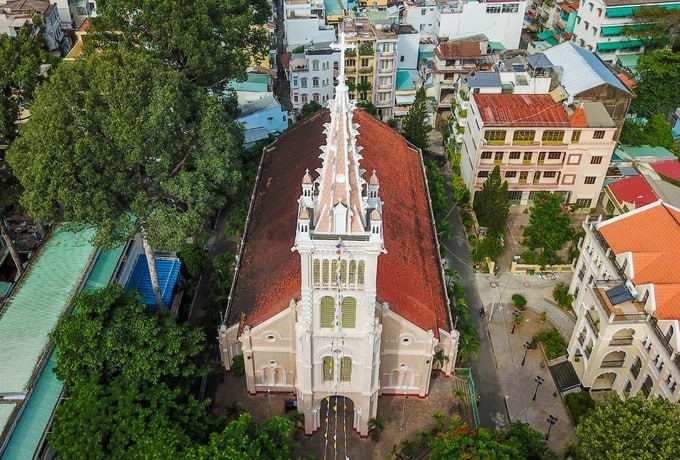
Cho Quan Church, or Basilica of the Sacred Heart of Jesus, might inspire your trip in Ho Chi Minh City a lot because there are a lot of things to say about nearly 300 years of its history.
1. Cho Quan Parish
The history of Cho Quan Parish associated with the process of expanding the territory of the Nguyen Dynasty to the south of Vietnam. At the end of the 17th century and the beginning of the 18th century, many parishioners, especially from Central Vietnam, who wanted to start a new business in the south or avoid war, conflict, conscription and famine, immigrated to the landscape and gathered together in a village named Xom Bot. In the village, they opened a market with many stands with the aim of serving the daily life of local residents. The market was named Cho Quan, which was used to call the surrounding neighborhood afterward.
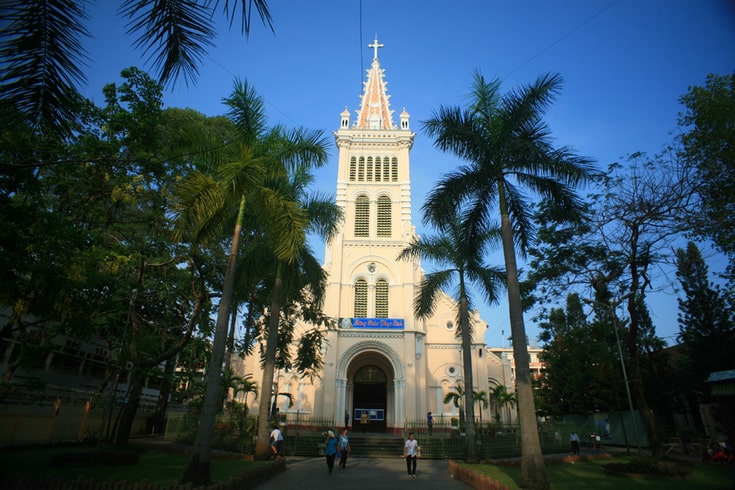
Cho Quan Parish was officially established in 1722. At that time, many zealous pastors came here to shepherd the Christian believers, from Franciscan to Vietnamese missionaries. Until 1725, the parish had about 300 parishioners. The missionaries had to face many difficulties when evangelizing due to the social conflicts and anti-Christian policy of the feudal government at that time. At the beginning of the formation, Cho Quan Parish had to suffer from dispersion in the years 1727, 1733, 1862 and 1882, then gathered again and developed up to present.
2. The Construction of Cho Quan Church
The first chapel of Cho Quan Parish was built in 1674 but it was not until 1723 that the Jesuit Priest Emmanuel Quitaon came to preach and convert the chapel into a church for the parishioners. After that, due to natural disasters and the destruction of people, Cho Quan Church was repeatedly demolished and rebuilt in the years 1727, 1733, 1793, 1862 and 1882.
In 1882 Priest Nicola Hamm began the construction of a new church. This work lasted for 14 years, through six priests and it was completed in 1896. The new church was inaugurated on the 4th day of the first lunar month of the year of the Monkey (1896). This is also the last construction of the church that we can see now. To memorize the contribution in building the church, after his death, Priest Nicola Hamm was buried in Cho Quan Church, next to the altar of Mother Mary.
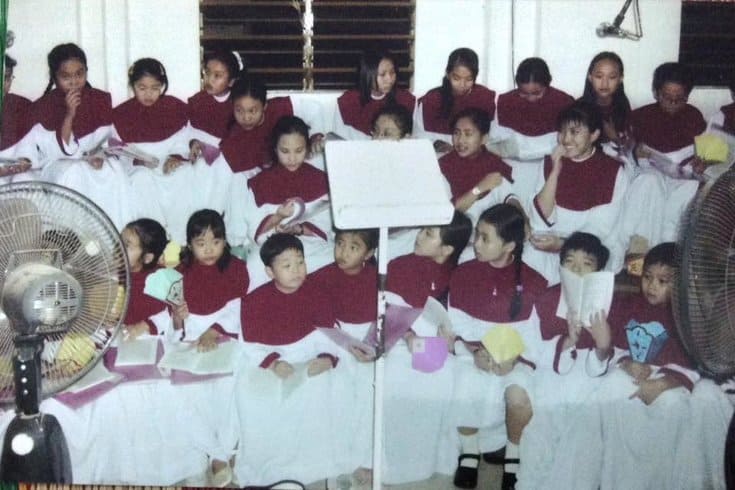
II. Highlights of Cho Quan Church
1. Structure
With a total area of 16,922 square meters, the construction of Cho Quan Parish includes not only the church but also many related constructions such as a public primary school, a house of charity and the yard and garden with many green trees. At present, Cho Quan Church has a charitable clinic that is under the management of District 5 Red Cross Association. In addition, it also has a community place for activities of people around here such as jogging, exercising in the morning or enjoying the fresh air in the park in front of the church.
The construction of the church includes a nave, a bell tower, a catechist with 12 rooms, a meeting hall, a remains and a reading room, all of which are arranged in a harmonious and beautiful way to bring a sense of relaxation and comfort to the parishioners as well as visitors.
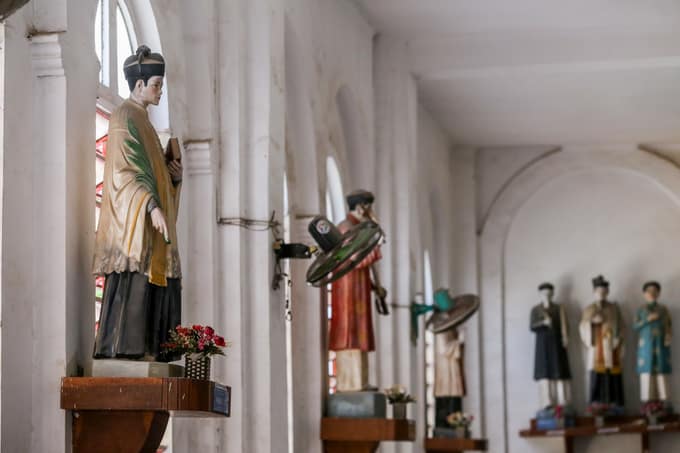
2. Architecture
The architecture of Cho Quan Church is typical for the Gothic architecture that can be seen in any Catholic work all over the world. However, there are many unique features that help Cho Quan Church be distinguished with others.
2.1. Outside Cho Quan Church
Taking an overall look, you will easily realize the typical Gothic structure in Cho Quan Church. The gate of Cho Quan Church is a lancet gate with iron grids in dark green, which is the most recognizable feature in the architecture of a Catholic church. On the gate arch is the name “Church of Cho Quan Parish” in bronze yellow, which is written in both English and Vietnamese. Walking through the gate, you will see a path between two tree lines leading to the main door.
Cho Quan Church is outstanding with the bright yellow color in the lush green tree around. The red tile roof of the church is covered with mossy antique, which makes a classic look for the whole construction. The arched doors and windows are arranged symmetrically in the front as well as the two sides of Cho Quan Church, creating a familiar feeling for people coming there. Besides, in the grounds surrounding Cho Quan Church, there is a stone cave in which Mother Mary is worshiped.
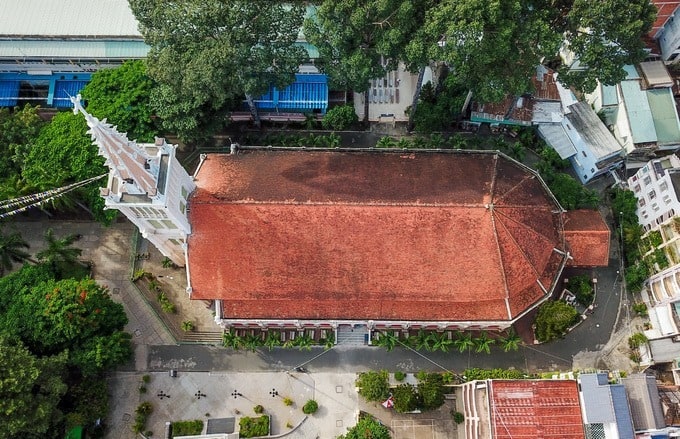
The most remarkable thing outside the church is surely the bell tower, which can be easily seen from afar. The bell tower of Cho Quan Church is quite different from other bell towers in a Catholic construction. It includes three floors, from low to high is the bell-pulling floor, the bell floor and the top one. There are five bells in the tower, two bells for weekdays, two for important occasions and one for funerals. Only on special holidays are all the five bells rung together. Another interesting thing about the bells is that the five bells were transported from France there by seaway and moved to the tower with the help of five elephants. Through the over-100-year history of this construction, the bell tower has been mended three times.
2.2. Inside Cho Quan Church
Stepping over the main door, you will be immediately immersed by the magnificent and luxurious appearance of Cho Quan Church. The large pillars put in two straight lines create depth for the main path and increase the impression of length and width for the interior. The correspondence between the height and the width of the main road can increase as well as reduce the sense of the height of the domes.
The church has four rows of big benches and two rows of small benches. On the left is the altar of Blessed Mother, on the right is the altar of St. Joseph. In the center of the nave is the sculpture of Jesus Christ on the cross, behind is another picture Jesus, and below that picture is a small entrance to the bell tower. In addition, there are also many small sculptures of Catholic Christ displayed vividly inside the church.
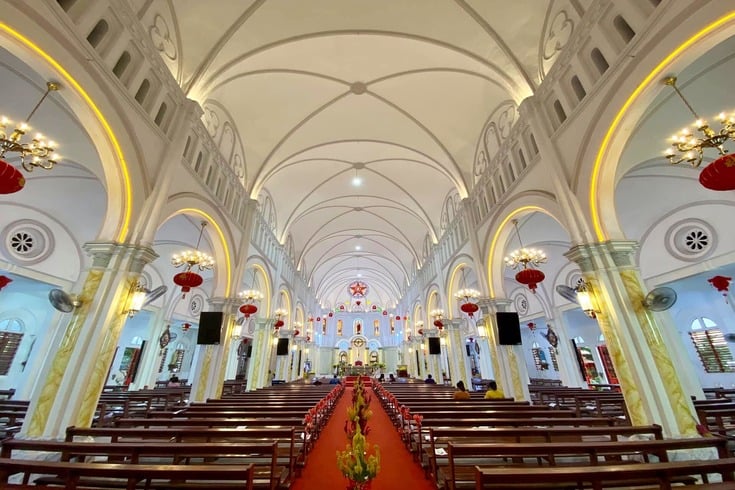
The color inside Cho Quan Church is the combination of the white of the arched ceiling, the bright yellow of pillars and the brown of furniture. The windows of Cho Quan Church are not the colorful stained glass windows that can be found in most of the Catholic churches in the nearby neighborhood. The two sides of the church are glass windows with horizontal pivots that allow the most natural light in the interior. All the details combine in harmony to create a solemn and shimmering beauty for Cho Quan Church.
III. What to Do at Cho Quan Church?
1. Shooting Gorgeous Photos
Cho Quan Church for sure is an ideal suggestion for you when coming to District 5, Ho Chi Minh City. The tranquil grounds as well as the yellow walls of Cho Quan Church will help you to have the most beautiful photos to show your friends and relatives at home. Moreover, you can choose to shoot pictures about the crowded streets and the daily life of the locals outside the church. That will be a wonderful way to discover Ho Chi Minh City.
2. Visiting the Neighborhood
Cho Quan Parish does not only have the construction of Cho Quan Church but also includes some other places such as Tu Duc Monastery and Cho Quan Cloister of Congregation of the Holy Cross Lovers. If you want to know more about Cho Quan Parish in particular and Catholicism in general, those would be most suitable for you.
In addition, you can come to visit other religious constructions, especially in Chinatown, which gives you some more intriguing knowledge about Chinese community in Ho Chi Minh City. Some suggestions for you are Cha Tam Church, Church of St. Joan of Arc, Ba Thien Hau Pagoda and Quan Am Pagoda.
3. Exploring Local Cuisine
Visitors as well as locals have a quote to describe Ho Chi Minh City, which is “Eating in District 5, sleeping in District 3, playing in District 1, being robbed in District 4”. District 5 is the most suitable destination for you to enjoy the cuisine of Vietnam and China, especially in Chinatown. Many mouth-watering specialties are waiting for your try such as popiah, sweet soya curd, mixed rice paper, meatball bread, dumpling and so on.

4. Joining Catholic Festivals
On special occasions of Catholicism such as Christmas and Easter, Cho Quan Church is decorated with many sparkling and colorful lights along the main path. Coming to this church after the sunset, you will be surprised at the shimmer there. This is also a good opportunity for you to know how a Catholic ceremony is performed.
IV. How to Get to Cho Quan Church?
Cho Quan Church is located in District 5, which is about three kilometers from District 1, the center of Ho Chi Minh City.
You can take a taxi or a Grab bike to visit Cho Quan Church. Besides, you can go by bus with a very cheap price then have a walk to reach the church. The buses that stop near Cho Quan Parish is bus numbers 01, 46 and 68.
V. Tips on Visiting Cho Quan Church
These following tips might be of some help to you when going to Cho Quan Church:
- Cho Quan Church is in a small lane and can be difficult to find. You should have a map in case you get lost.
- Street robbery in Ho Chi Minh City is quite dangerous, so be careful with your belongings.
- Don’t forget to bring a mobile phone with a good camera to have the most beautiful photos.
- You should not go out at rush hour in Ho Chi Minh City, it is such a waste of time!
- Remember to protect the environment in the grounds of Cho Quan Church.
Through the up and down of history, Cho Quan Church still remains the values of a Catholic community. In comparison to other churches, it is a more suitable place for those who want to enjoy the peaceful moments in the crowded city. If you have a chance to visit District 5, don’t miss this impressive destination.
Explore the place
The City Maps
Reviews






